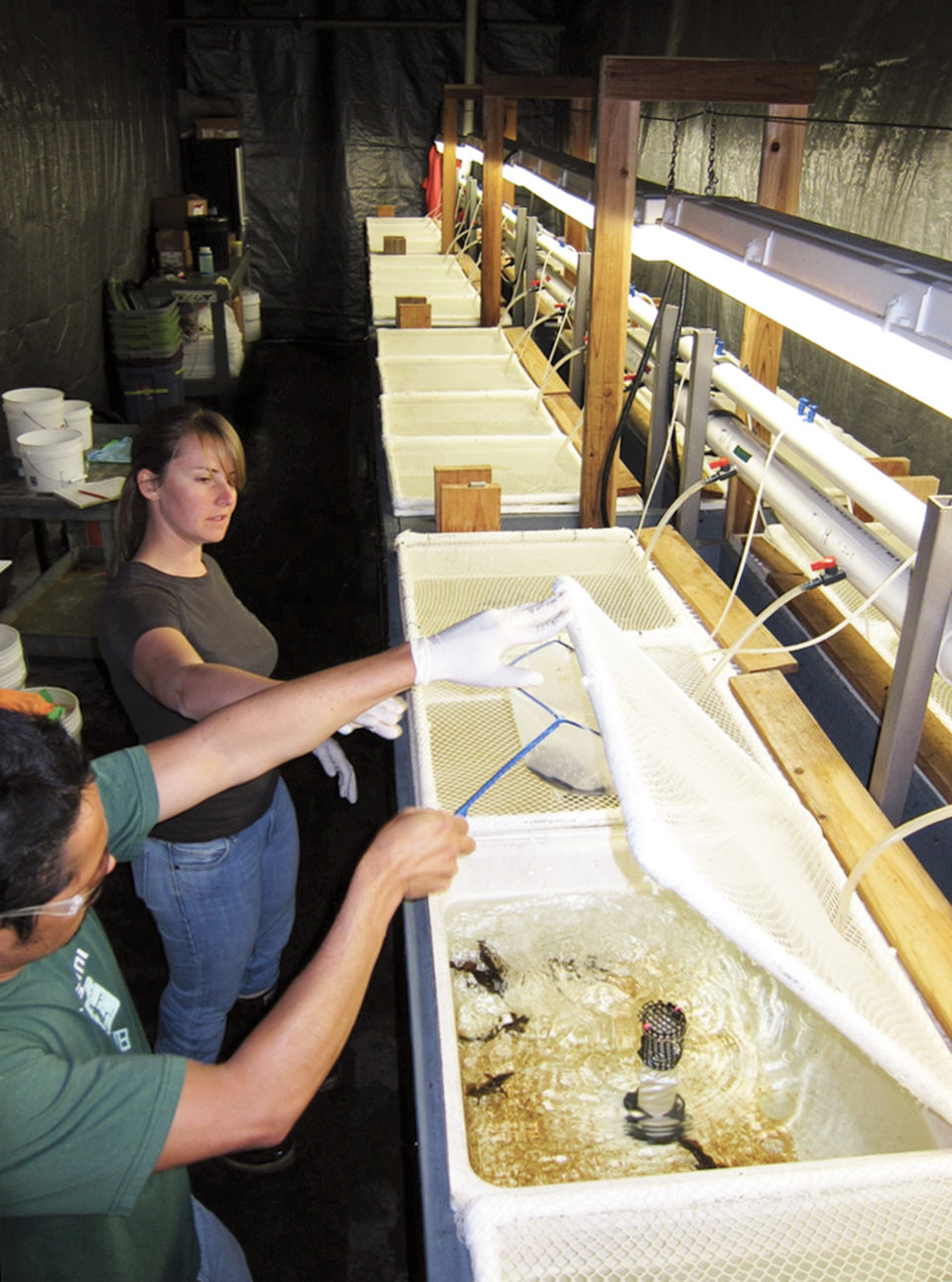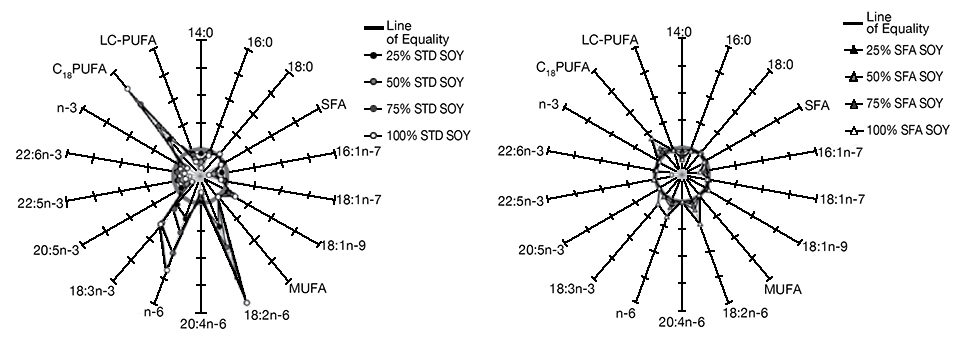Omega-3 requirements could be effectively reduced via SFA-rich alternative lipids

Fish oil sparing has proven particularly difficult for fish species that require one or more of the long-chain polyunsaturated fatty acids (LC-PUFAs), which are abundant in fish oil, but lacking in most of the alternative fats and oils commonly used in aquafeeds. Carnivorous fish, especially marine carnivores like the white sea bass (Atractoscion nobilis) are particularly demanding in this context. For these species, complete or near-complete fish oil replacement generally impairs growth performance and dramatically alters the fatty acid composition of the tissues.
Recent studies have suggested that the use of lipids rich in saturated fatty acids (SFAs) instead of those rich in C18 polyunsaturated fatty acids (C18 PUFAs) may be advantageous in maintaining tissue levels of LC-PUFAs. SFA-rich lipids may also offer a strategic advantage in terms of meeting the LC-PUFA requirements of marine carnivores while minimizing dietary fish oil inclusion.
Initial feeding trial
Accordingly, the authors assessed the performance and tissue fatty acid composition of juvenile white sea bass initially weighing 3.8 + 0.2 g fed diets containing fish oil, graded levels of C18 PUFA-rich standard soy oil or SFA-rich hydrogenated soy oil (replacing 25, 50, 75, or 100 percent of dietary fish oil) for eight weeks.
Feed conversion, weight gain and specific growth rates were not impaired by partial or complete replacement of dietary fish oil with hydrogenated soy oil. However, fish oil sparing with standard soy oil was associated with declining performance. Tissue fatty acid profiles of fish fed the SFA-rich, hydrogenated soy oil-based diets were very similar to those fed the fish oil-based feed, but the C18 PUFA-rich standard soy oil-based feeds resulted in concomitant loss of n-3 and LC-PUFAs (Fig. 1).

These data suggested a limitation, potentially related to LC-PUFA deficiency, associated with replacing fish oil with standard soybean oil but not with hydrogenated soybean oil.
Follow-up trial
In a subsequent feeding trial, the authors tested whether the limitations associated with feeding standard soybean oil to white sea bass could be attenuated by the addition of an algal source of docosahexaenoic acid (22:6 n-3, DHA). This experiment assessed the performance and tissue fatty acid compositions of juvenile white sea bass weighing 4.1 g fed diets containing fish oil, C18 PUFA-rich standard soy oil or SFA-rich hydrogenated soy oil as a complete fish oil replacement, with or without DHA supplementation for eight weeks. Once again, the use of C18 PUFA-rich standard soybean oil-based feed resulted in impaired growth fish and feed-conversion ratios. Although amending the diet with DHA did improve the performance of fish fed standard soybean oil-based feed, growth was still superior among the fish fed hydrogenated soybean oil-based feeds, regardless of DHA supplementation.
Perspectives
Collectively, the data suggested that the LC-PUFA requirements of white sea bass could be effectively reduced by feeding SFA-rich alternative lipids like hydrogenated soybean oil, allowing for a greater level of fish oil sparing without growth impairment or tissue profile modification than is possible with C18 PUFA-rich lipids.
To fully validate these results and the value of hydrogenated soybean oil-based white seabass feed, a commercial-scale grow-out trial is currently being conducted by Hubbs-SeaWorld Research Institute in cooperation with researchers at Southern Illinois University and Iowa State University.
Editor’s Note: This article was based largely on research by the authors reported in “Sparing Fish Oil With Soybean Oil in Feeds for White Seabass: Effects of Inclusion Rate and Soybean Oil Composition,” an article published in the April 2013 North American Journal of Aquaculture.
(Editor’s Note: This article was originally published in the November/December 2014 print edition of the Global Aquaculture Advocate.)
Authors
-

Jesse Trushenski, Ph.D.
Center for Fisheries, Aquaculture and Aquatic Sciences
Department of Zoology
Southern Illinois University Carbondale
Carbondale, Illinois 62901 USA[117,100,101,46,117,105,115,64,105,107,115,117,108,97,115]
-
Bonnie Mulligan
Center for Fisheries, Aquaculture, and Aquatic Sciences
Department of Zoology
Southern Illinois University Carbondale -
David Jirsa
Hubbs-SeaWorld Research Institute
San Diego, California, USA -
Mark Drawbridge
Hubbs-SeaWorld Research Institute
San Diego, California, USA
Tagged With
Related Posts

Aquafeeds
Improving productivity, efficiency in Asian sea bass aquaculture
The effects of the dietary acidifier and feed additive potassium diformate (KDF) were tested in diets of juvenile Asian seabass (Lates calcarifer) in Thailand. Results show that including KDF at 0.5 percent in the diets can help improve growth, survival and therefore overall production of this species.

Intelligence
Adding flavor complexity to farmed barramundi
Organoleptic attributes such as flavor and aroma are among the most important factors that influence consumer acceptability and demand for fish products. Consumers have identified farmed fish as less complex and lacking “sealike” or “sea-fresh” flavors and aromas.

Aquafeeds
Alternative feed ingredient universe to convene at F3 meeting
What started out as a simple yet ambitious contest to drive innovation in the aquafeed sector has evolved into a fully global competition – and collaboration – amongst ingredient suppliers and feed manufacturers.

Aquafeeds
A look at phospholipids in aquafeeds
Phospholipids are the major constituents of cell membranes and are vital to the normal function of every cell and organ. The inclusion of phospholipids in aquafeeds ensures increased growth, better survival and stress resistance, and prevention of skeletal deformities of larval and juvenile stages of fish and shellfish species.


